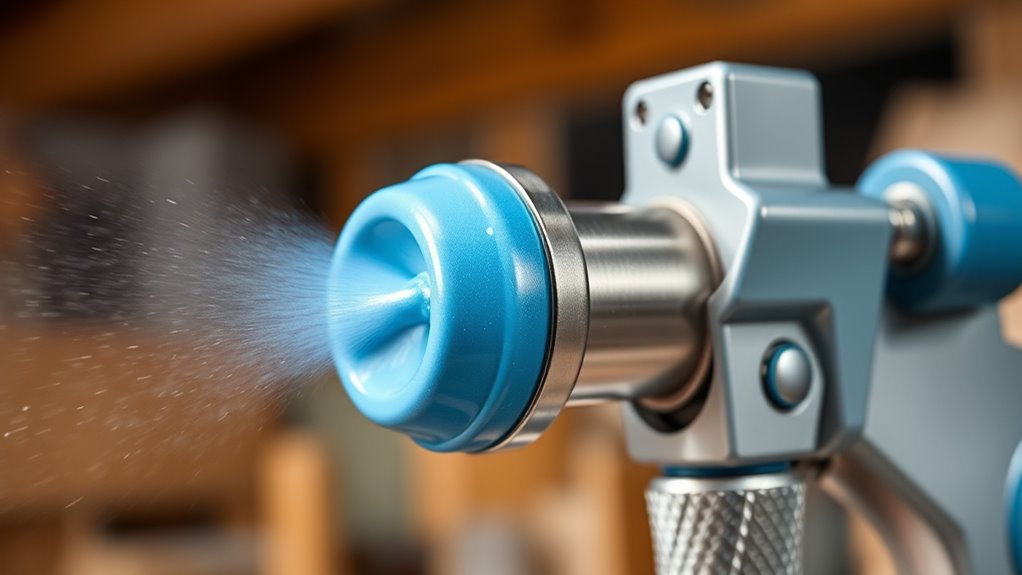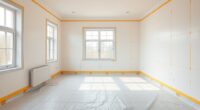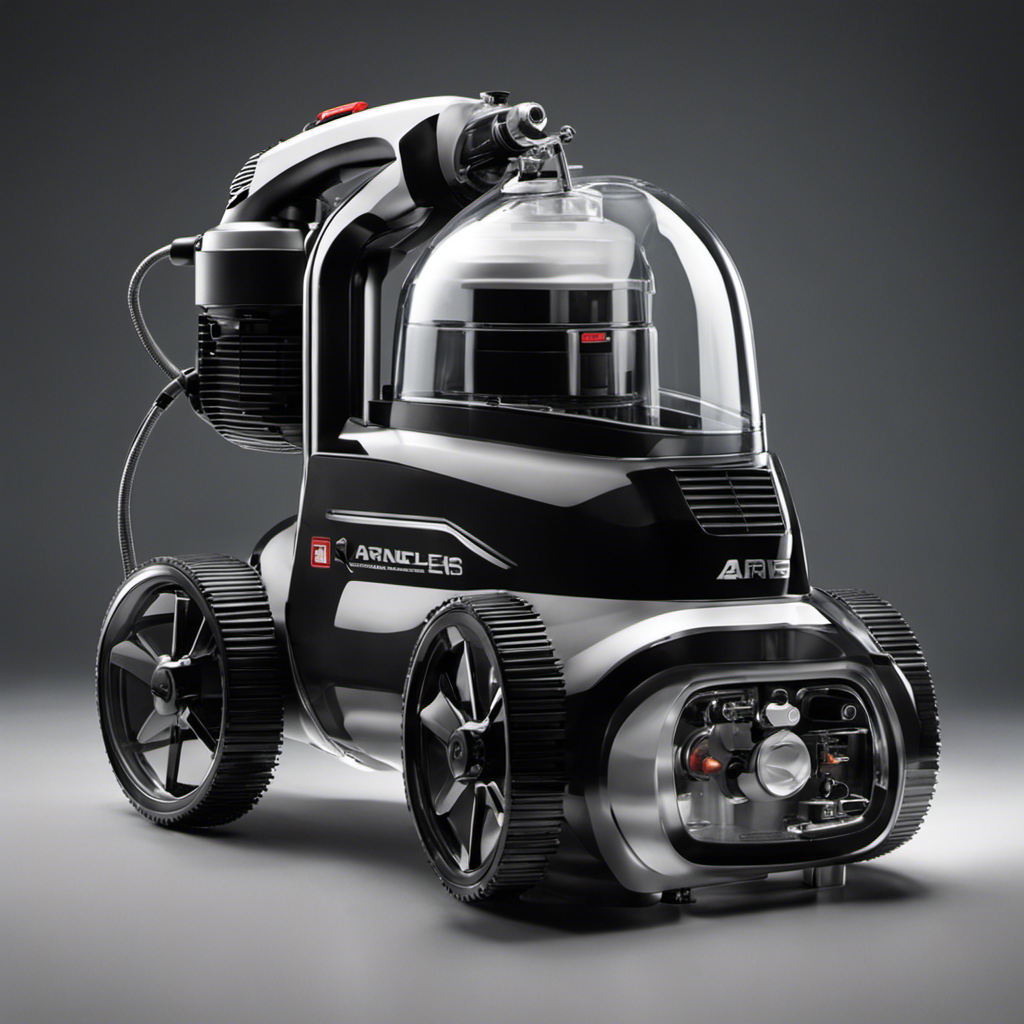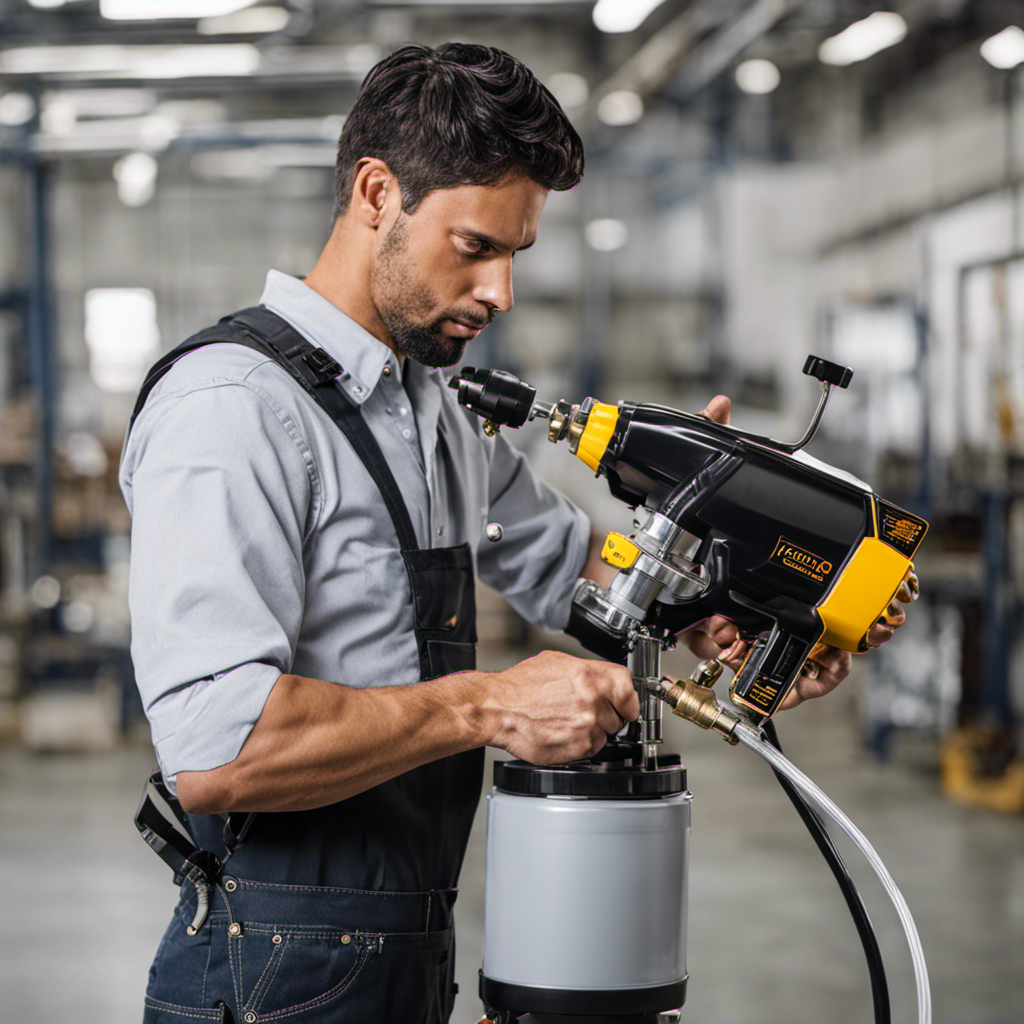Yes, you can use house paint in a spray gun, but you need to prepare it properly first. Thin the paint with the right amount of solvent or water, and strain it to prevent clogs. Choose a paint labeled as “spray-ready” or compatible with spray equipment. Make sure your spray gun is suited for the paint’s viscosity, and always test on scrap surfaces. For all the tips and techniques, keep exploring how to get the best finish.
Key Takeaways
- Yes, but ensure the house paint is compatible with spray application and has a thinner, spray-ready consistency.
- Thin the paint according to manufacturer guidelines to achieve proper flow and prevent clogs.
- Strain the paint through a fine mesh filter to remove debris before spraying.
- Use a suitable spray gun with adjustable pressure and nozzle size for optimal results.
- Proper surface preparation and testing on scrap surfaces improve the finish quality when spraying house paint.
Types of House Paint Suitable for Spray Guns
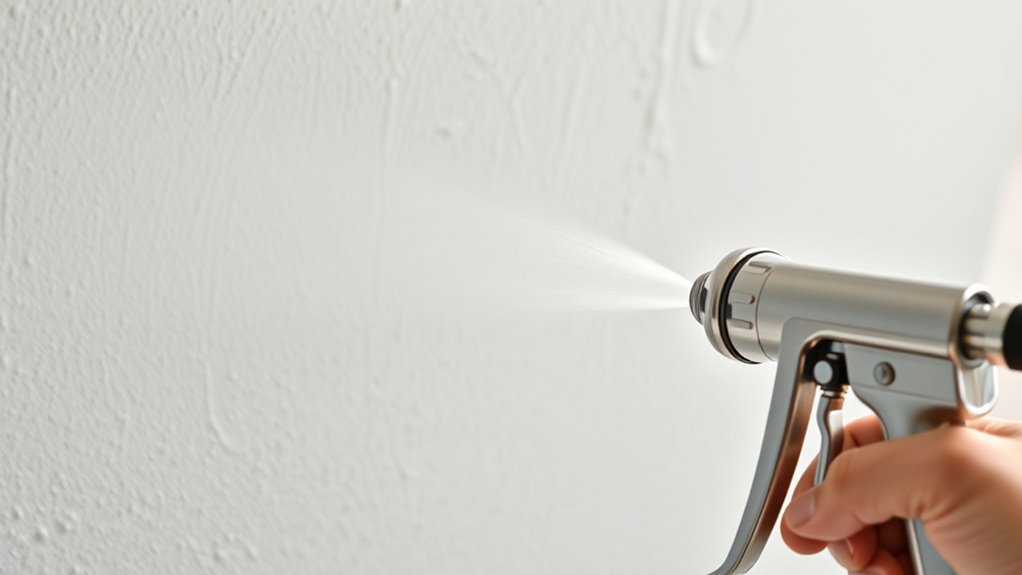
When choosing house paint for a spray gun, it’s important to select formulations that are compatible with spray application. Suitable paints typically have a thinner consistency, often achieved by using milder solvents or pre-mixed products designed for spraying. These paints allow you to maintain smooth, even coverage without clogging the nozzle. While brush techniques work well for detail work, spray guns excel at covering large surfaces quickly. Accurate paint color matching becomes easier with spray methods, as you can blend shades seamlessly for a uniform look. Look for paints labeled as spray-ready or those that specify compatibility with spray equipment. Using the right type of paint ensures smooth application, vibrant colors, and professional results. Additionally, choosing paints with appropriate fluid viscosity helps prevent clogging and ensures a consistent spray pattern. Ensuring the paint has the right particle size is also crucial for achieving a smooth finish and avoiding nozzle blockages. Proper preparation, such as filtering the paint, can further improve spraying outcomes and reduce clogging risks.
Preparing House Paint for Spray Application

Before spraying, you need to prepare your house paint properly. This means thinning the paint to the right consistency, straining it for a smooth finish, and adjusting your spray equipment accordingly. Getting these steps right guarantees a clean, even coat on your surfaces. Additionally, selecting the appropriate tuning techniques can further enhance your project’s results. Proper digital literacy can also help you troubleshoot issues during spraying and ensure safety during your project. Understanding paint formulations can help you choose the best type of paint for spraying and achieve optimal results. Being aware of proper storage methods can also prevent paint from drying out or clogging your sprayer during projects. Moreover, understanding sound healing science can inspire creative ways to incorporate calming environments while working.
Thinning the Paint Properly
To achieve a smooth spray finish, proper thinning of house paint is essential before application. Start by checking the paint’s color and branding to determine the recommended thinning ratio. Most paint brands provide guidelines on how much thinner to add for spraying, which helps maintain consistent color and finish. Use the appropriate thinner—usually water for latex paints or mineral spirits for oil-based paints—and add it gradually. Mix thoroughly to ensure the paint becomes flowable without losing coverage or color integrity. Keep in mind that over-thinning can cause drips, while under-thinning leads to clogs. Adjust the consistency until the paint flows smoothly from the spray gun, guaranteeing even coverage and a professional-looking finish. Proper paint consistency is crucial for achieving a flawless spray application. Additionally, testing the spray on a scrap surface can help verify the correct thinning ratio before starting on the actual project. For best results, consider paint viscosity to ensure the paint is at the optimal flow level for spraying. Ensuring the right application technique can also significantly impact the final appearance and efficiency of your project. Remember that the quality of the spray equipment also plays an important role in achieving a smooth finish.
Straining for Smooth Finish
Achieving a smooth, professional-looking spray finish starts with properly straining your paint. This step ensures consistent paint flow and prevents clogs, which can ruin your work. Use a fine mesh filter to remove debris and thickened paint chunks, maintaining ideal paint consistency. The right nozzle selection depends on the paint’s viscosity; a finer nozzle works best for thinner paint, while a wider one suits thicker formulations. Proper paint preparation techniques can also be maintained by ensuring paint remains free of mineral deposits and buildup that could clog spray equipment. Additionally, regularly inspecting and cleaning your spray gun helps prevent clogging issues that might compromise your finish. Being aware of water-based vs. oil-based paints and their respective preparation needs can further improve your spraying results.
Adjusting Spray Equipment
Once your paint is properly strained and has the right consistency, the next step is to modify your spray equipment for ideal application. Start by calibrating the spray tip and pressure settings to match the paint’s viscosity. Keep your brush techniques in mind—maintain a steady, consistent motion for even coverage. Proper paint storage is essential; keep your paint covered and at the right temperature to prevent it from thickening or drying out. Adjust the spray gun’s flow rate and fan pattern to suit the surface area and texture you’re working on. Test spray on a scrap piece to ensure a smooth spray pattern. Being aware of retirement planning and emotional manipulation can help you recognize and avoid emotional triggers during stressful projects. Additionally, understanding affairs and their emotional impact can inform how you approach communication during challenging tasks. Controlling the spray pattern based on vehicle tuning principles, such as controlling flow rate and pattern, can help achieve a professional finish and prevents issues like drips or uneven coverage.
Equipment Needed for Spraying House Paint
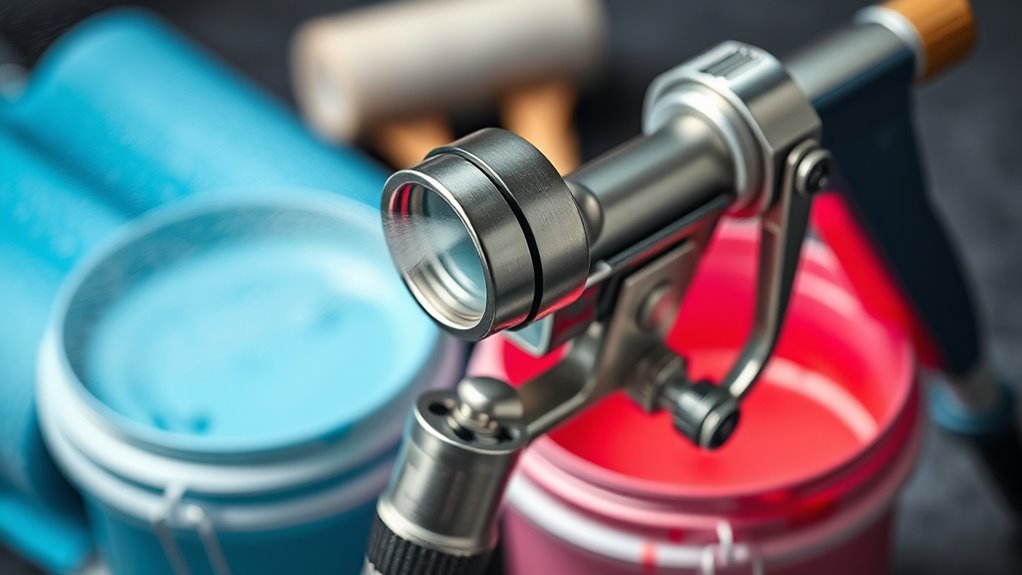
To get started, you’ll need the right spray gun designed for house paint, along with safety gear like masks and goggles. Ensuring your equipment is suitable and in good condition makes a big difference in your results. Additionally, proper paint preparation is essential for a smooth, even finish. For the best results, consider using a properly tuned spray gun to optimize paint flow and coverage.
Suitable Spray Guns
Choosing the right spray gun is essential for applying house paint effectively. You’ll want a gun designed for thicker paints to prevent clogging and guarantee smooth application. Look for models with adjustable flow rate and spray pattern to help with color matching and achieve even coverage. A suitable spray gun also has a reliable paint storage system, making refills straightforward and minimizing mess. Electric or airless sprayers are popular choices, as they handle larger projects efficiently. Make sure the gun’s nozzle is compatible with the viscosity of your paint, especially if you’re using house paint straight from the container. Proper equipment will give you better control, consistent results, and easier clean-up, ultimately making your painting project more successful. Additionally, selecting a spray gun with tuning capabilities can help optimize performance for different paint types and project requirements. Using a spray gun with adjustable pressure can further improve application quality and reduce overspray. For best results, consider a nozzle size suitable for the thickness of house paint to prevent clogs and ensure even spray coverage. It’s also beneficial to select a spray gun that is compatible with various paint viscosities, allowing flexibility for different coatings.
Necessary Safety Gear
When spraying house paint, wearing the proper safety gear is essential to protect yourself from hazards like fumes, overspray, and skin contact. First, you should wear protective clothing, such as coveralls or long sleeves, to prevent paint from contacting your skin. Second, respiratory protection is vital; a mask or respirator helps prevent inhaling harmful fumes and overspray particles. Finally, make sure you have safety goggles or eye protection to shield your eyes from splatters and airborne paint. These safety measures minimize health risks and keep you safe during the painting process. Remember, investing in good protective gear isn’t just smart—it’s necessary for your safety and well-being. Stay protected, and your project will go smoothly.
Proper Paint Preparation
Before you start spraying house paint, it’s important to gather the right equipment to guarantee a smooth and efficient process. You’ll need a high-quality spray gun suitable for house paint, along with a paint mixer for proper color mixing. Ensuring the paint is well mixed prevents uneven coverage and color discrepancies. Use a strainer to filter out debris, which can clog your spray gun and affect finish quality. Pay attention to environmental considerations by working in ventilated areas and using protective gear to minimize paint fumes. Proper preparation also includes thinning the paint to the right consistency for spraying, which helps achieve a smooth, professional finish. Having the right equipment and preparation steps in place makes your painting project safer, cleaner, and more successful.
Techniques for Achieving a Smooth Finish

Achieving a smooth finish with your spray gun starts by preparing your surface properly. To guarantee the best results, focus on consistent paint mixing and precise color matching. First, thoroughly mix your paint to prevent uneven texture or clumps. Second, match your paint color accurately for a uniform appearance, especially if blending new paint with existing surfaces. Third, maintain a steady hand and consistent distance from the surface—about 6 to 12 inches—to avoid streaks and drips. Keep your spray gun at a constant speed and overlap each pass slightly to achieve even coverage. Practice on scrap material if needed. These techniques, combined with proper paint preparation, will help you attain a smooth, professional-looking finish.
Common Challenges and How to Avoid Them

Even with proper preparation, spray painting can present some common challenges that may affect your final finish. One issue is paint compatibility; using the wrong type of house paint can cause clogging or uneven coverage. Environmental concerns also matter—poor ventilation or outdoor conditions can affect drying and finish quality. To avoid these problems, check your paint’s compatibility with spray equipment and ensure proper mixing. Additionally, consider environmental factors like humidity and temperature, which can impact application. Use the table below to identify common challenges and solutions:
| Challenge | Solution |
|---|---|
| Clogging or sputtering | Strain paint and use the right nozzle size |
| Uneven finish | Maintain consistent spray distance and speed |
| Poor adhesion | Proper surface prep and compatible paint use |
| Environmental issues | Work in suitable conditions, avoid high humidity |
Cleaning and Maintenance of Spray Equipment

Proper cleaning and maintenance of your spray equipment are essential to guarantee consistent performance and a high-quality finish. To keep your spray gun functioning well, follow these steps:
- Rinse the gun thoroughly immediately after use with the appropriate solvent for your paint color and brand. This prevents paint from drying inside the nozzle.
- Disassemble and clean all parts, paying attention to the nozzle and filters, ensuring no paint residue remains.
- Regularly lubricate moving parts and inspect for wear, especially if switching between different paint brands or colors, to maintain best performance.
Frequently Asked Questions
Can Oil-Based House Paint Be Used in a Spray Gun?
You wonder if oil-based house paint can be used in a spray gun. To guarantee proper paint compatibility, check your spray gun types—some are designed for oil-based paints, while others work best with water-based ones. Oil-based paints require specific sprayers, like airless or HVLP systems, and proper thinning. Always follow manufacturer guidelines to prevent clogs and achieve a smooth finish, avoiding damage to your equipment.
How Do I Thin Latex Paint for Spray Application?
Imagine smooth, flowing paint gliding effortlessly through your spray gun. To achieve this, you need the right paint consistency. Thin latex paint by slowly adding water, about a tablespoon at a time, stirring thoroughly. Use thinning techniques like straining the paint to remove lumps. Keep testing the consistency until it’s fluid enough to spray evenly, without clogging or drips. This guarantees a flawless finish every time.
What Safety Precautions Are Necessary When Spraying House Paint?
When spraying house paint, you need to prioritize safety. Always wear protective gear like masks, goggles, and gloves to avoid inhaling fumes and contact with skin. Set up proper ventilation, such as open windows and fans, to disperse fumes and prevent buildup. Make certain you’re in a well-ventilated area, and follow the manufacturer’s safety instructions. Taking these precautions minimizes health risks and ensures a safer, more effective painting process.
How Long Does It Take for Spray-Painted House Paint to Dry?
Imagine catching a glimpse of your freshly spray-painted wall, wondering when the paint drying process will finish. Typically, spray application allows paint to dry within 1-2 hours to touch, but it’s best to wait 24 hours before heavy use. Factors like humidity and paint type influence drying time. To guarantee a smooth finish, give your paint ample time to dry thoroughly, avoiding any accidental smudges or damage.
Is It Possible to Spray Paint on Textured or Uneven Surfaces?
You can definitely spray paint on textured or uneven surfaces. Just make sure to choose a spray nozzle suitable for rough surfaces to prevent uneven application. Hold the spray gun at the right distance, usually about 6-12 inches, to evenly cover textured surfaces. Applying multiple thin coats rather than one thick coat helps achieve a smooth finish on uneven surfaces. With proper technique, spray painting works well on all types of surfaces.
Conclusion
Using house paint in a spray gun is totally doable if you know how to prepare it right. With the right equipment and techniques, you’ll achieve a smooth, professional finish that makes your home look like it was painted by a pro. Just remember, proper cleaning and maintenance keep your tools in top shape, like a well-oiled machine. So go ahead, release your inner artist and transform your space with confidence—you’ve got this!
A seasoned painter with over 15 years in the industry, Mike transitioned from hands-on painting projects to the digital world of paint sprayers. His extensive experience gives him a unique perspective on what users truly need when it comes to painting tools. As the Editor in Chief of Paint Sprayer Zone, Mike ensures that every piece of content not only provides value but also reflects the realities of painting — the challenges, the joys, and the intricate details.
